|
The Hoods Woods website surival.com has been updated to present you with a fresh new look and new functionality for your convenience.
The page you are looking for can now be found here.
Please make sure to update your links and bookmarks with the new address because this page nor this site will be receiving any future updates. If you would like to be sure to keep up with what the Hoods are up to, you will want to take advantage of our new site.
Webmasters:
If you are reaching this page during a test of your links, please make sure to update your link with the new link found above to ensure that your visitors are getting the most current and up to date information.

Woodsmaster© Volume 7
Jungle Living Skills
|
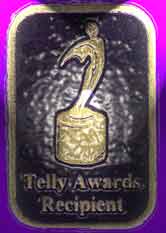
|
Hoods Woods won a 1st place for the Best Non-Broadcast Documentary Telly award for this video This outstanding video won us one of the two awards we won in the Telly Awards competition for 2001.
We also a 2nd place in the Best Instructional video category for our Primitive Knifemaking video.
More about the Telly awards can be found here
|
|
of the Candoshi-Shapra Indians - Hosted By Ron & Karen Hood
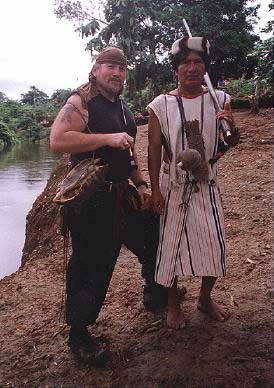
Available NOW!
Woodsmaster - Volume seven
Volume 7 of the Woodsmaster survival library takes you into the jungle!
During 1998-99 Ron and Karen Hood spent nearly four months, during two trips in the Peruvian Amazon, living with the Candoshi - Shapra Indians. These Indians, noted for their head-shrinking techniques and prowess with blowguns, are also the masters of jungle living skills.
Once you’ve seen this astonishing video you’ll have a grasp of the amazing variety of skills required to live off the land.
You’ll see how to make a blowgun, brew jungle beer and make bowls and lamps. Learn how to clean and cook monkey, turtle, Toucan and giant grubs. You’ll learn about jungle plants and their uses as well as witness the work of a Shapra Shaman. See as we gather plants for use as a fish poison and then work it in a stream. Drink mud? Yep, they do... Why? Because it is refreshing (like spit beer)!
Watch them as they hunt game and navigate in the dense jungle. See how they make string and fabric. This video is so full of material.... you’ll have to watch it to believe it.
With Karen and Ron Hood as your guides, you'll SEE what it takes to live in the jungle.
If Discovery had balls.... this would be what they show!
If you think you'll never need the skills in this video... you're wrong. The skills we captured were chosen for their cross cultural and trans-environmental value. Furthermore it is important for ANY student of survival or wilderness living to understand how much work is required to stay alive even in the most productive of environments... the jungle.
Caution... This video contains graphic scenes!
Photos from the Jungle
|
|
 Apu Basha is the headman of the Shapra-Candoshi Indian village we visited. He and his people live as hunter-gatherers at the headwaters of the Amazon. Basha's people had not seen outsiders for several decades. He and a few of his hunters occasionally trade down river for essential supplies like shotgun shells, medicine and salt. Here Basha is holding his traditional blowgun. I've got a jungle land turtle hanging from my shoulder. Soon it was a nice meal. Apu Basha is the headman of the Shapra-Candoshi Indian village we visited. He and his people live as hunter-gatherers at the headwaters of the Amazon. Basha's people had not seen outsiders for several decades. He and a few of his hunters occasionally trade down river for essential supplies like shotgun shells, medicine and salt. Here Basha is holding his traditional blowgun. I've got a jungle land turtle hanging from my shoulder. Soon it was a nice meal.
Oddly, when we arrived, the Indians dropped their traditional clothes in favor of their "Sunday-go-to-meetin" clothes ... civvies. I asked Basha about this and he said that his people wanted to make us feel comfortable. So they wore slacks, Levi's and Adidas shirts. After a few weeks they started to relax, and returned to their native garb.
|
|
A Welcome ceremony
|
|
 After welcoming us, APU (Chief) Basha presented me with his Corona, his symbol of power. The hair hanging from the ends of the tassels traditionally represents the men he has killed. In this case - four. After welcoming us, APU (Chief) Basha presented me with his Corona, his symbol of power. The hair hanging from the ends of the tassels traditionally represents the men he has killed. In this case - four.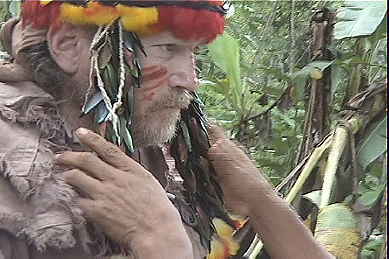
|
|
See the entire Blowgun making process from two slabs of wood to the finished product!
|
|
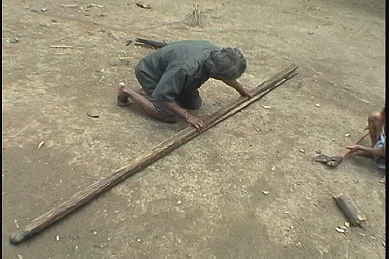 Learn how they bore the channel for the dart, align the halves and smooth the bore. Learn how they bore the channel for the dart, align the halves and smooth the bore.
|
|
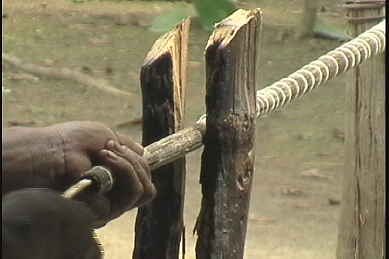 Here the bore is smoothed with a special pole and a grinding compound you can easily make. Here the bore is smoothed with a special pole and a grinding compound you can easily make.
|
|
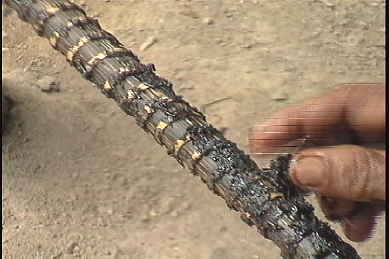 Basha applies the sealing mixture that makes the blowgun airtight. Basha applies the sealing mixture that makes the blowgun airtight.
|
|
Strange animals!
|
|
 Is Karen REALLY going to eat that Sloth? Naw... but you'll see where the word "slothful" gets it's meaning! Is Karen REALLY going to eat that Sloth? Naw... but you'll see where the word "slothful" gets it's meaning!
|
|

You'll also get a chance to see how to make a simple jungle snare.... easy!
|
|
Monkey munching!
|
|
 While I'm not usually into eating relatives, this particular one (The one with the tail) is pretty tasty. While I'm not usually into eating relatives, this particular one (The one with the tail) is pretty tasty.
|
|
 It's a pretty appetizing picture... right? It's a pretty appetizing picture... right?
|
|
 Ron is surprised by his resemblance to his meal! Our Night vision camera made it possible to capture everything... even the stuff done in darkness! Ron is surprised by his resemblance to his meal! Our Night vision camera made it possible to capture everything... even the stuff done in darkness!
|
|
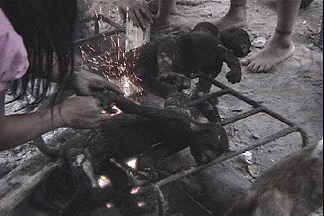 Learn how to clean and cook a monkey. Learn how to prepare it for long term storage and more. Learn how to clean and cook a monkey. Learn how to prepare it for long term storage and more.
|
|
Here Karen helps to prepare Masato "Beer".
|
|
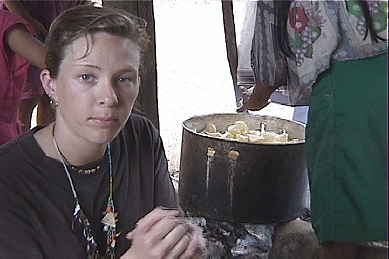 Karen said that mashing the Yucca to make the beer was very hard work. Thank God! After drinking a few gallons of the Masato I've decided that I like my beer from bottles. Just want to save Karen the work.... Amazing what women will go through to please their men! Karen said that mashing the Yucca to make the beer was very hard work. Thank God! After drinking a few gallons of the Masato I've decided that I like my beer from bottles. Just want to save Karen the work.... Amazing what women will go through to please their men!
(HINT.. Don't eat before you watch this sequence!)
|
|
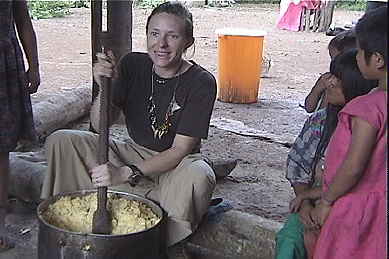
The Indians use an old oar from a dugout canoe as a yucca masher. They were delighted that Karen would give it a try. "Wapari, Wapari" they said "Thank you, thank you!"
|
|
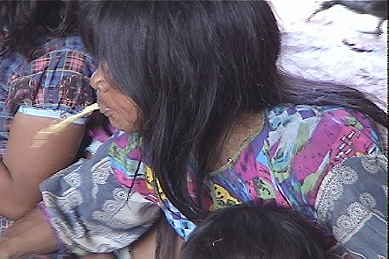 The traditional "spit beer" is consumed by the men. The woman here is hocking a loogie into the beer to improve the taste! Man! that looks like good spit! The traditional "spit beer" is consumed by the men. The woman here is hocking a loogie into the beer to improve the taste! Man! that looks like good spit!
Amazing what guys will go through to please their women ;> )
See the entire process!
|
|
Making Pottery!
|
|
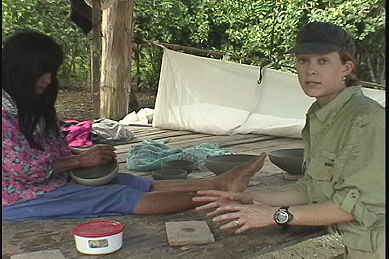 So the Guys down their Masato every night... What do they drink from? Karen shows you every step from making the clay to forming the bowl to decorating, firing and finishing. Learn how they make pottery from clay, without the aid of a spinning table or a firing oven. It all has to do with wood ash and crafts skills. An amazing sequence which will have you wanting to make your own bowls.. maybe. So the Guys down their Masato every night... What do they drink from? Karen shows you every step from making the clay to forming the bowl to decorating, firing and finishing. Learn how they make pottery from clay, without the aid of a spinning table or a firing oven. It all has to do with wood ash and crafts skills. An amazing sequence which will have you wanting to make your own bowls.. maybe.
|
|
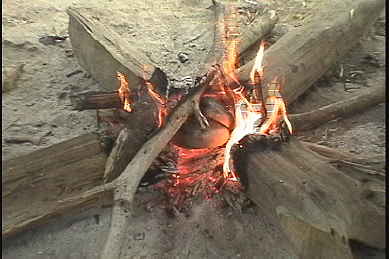 Bowls being fired in an open fire. You see how they set up the fire to make this process work. Bowls being fired in an open fire. You see how they set up the fire to make this process work.
|
|
 Here, Karen puts the finishing touches on a bowl before firing. Here, Karen puts the finishing touches on a bowl before firing.
|
|
|
The people
|
|
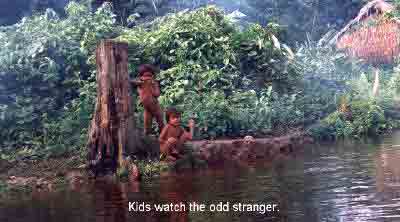 The village kids were both curious and fearful at first. They soon warmed to us strangers. Sadly, many of the children suffer from parasitic infections and forms of malnutrition common to the jungle diet. You'll see some of the effects of disease, and the causes for it, in the video. The village kids were both curious and fearful at first. They soon warmed to us strangers. Sadly, many of the children suffer from parasitic infections and forms of malnutrition common to the jungle diet. You'll see some of the effects of disease, and the causes for it, in the video.
|
|
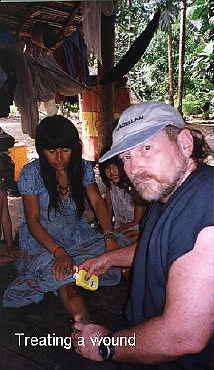 Injuries are common in the jungle and we treated as many as possible. This woman had a wound to the leg that was infected down to the bone. We drained the infection and, with the help of antibiotics, saw her healing within a week. We also conducted some classes on basic hygiene. Villagers would often urinate a few feet from their cooking fires. Dogs would eat the defecation. Someone found the barrel (seen in the background), floating in the river down stream... they towed it 50 Km back with a dugout and now it collects rainwater for drinking. Who knows what chemicals the barrel might have contained? In the video you'll not only see this woman but you'll get to watch a shamanistic healing ceremony conducted on our expedition leader, Mark Sexton. The Indians quit doing shamanism after a series of wars broke out. These wars claimed hundreds of heads all of which were taken back and shrunk. Injuries are common in the jungle and we treated as many as possible. This woman had a wound to the leg that was infected down to the bone. We drained the infection and, with the help of antibiotics, saw her healing within a week. We also conducted some classes on basic hygiene. Villagers would often urinate a few feet from their cooking fires. Dogs would eat the defecation. Someone found the barrel (seen in the background), floating in the river down stream... they towed it 50 Km back with a dugout and now it collects rainwater for drinking. Who knows what chemicals the barrel might have contained? In the video you'll not only see this woman but you'll get to watch a shamanistic healing ceremony conducted on our expedition leader, Mark Sexton. The Indians quit doing shamanism after a series of wars broke out. These wars claimed hundreds of heads all of which were taken back and shrunk.
Head shrinking was banned by the Peruvian government so the Indians keep the practice quietly.
|
|
 Insect bites were a problem. Some folks are much more attractive to insects than others. Despite DEET and other precautions, this member of our crew was attacked by chiggers, mosquitoes and Zanguros (tiny mosquitoes). His legs were worse. Topical lidocaine, cortisone cream and Benadryl helped him some. My guess is that he won't want to come back next time! Insect bites were a problem. Some folks are much more attractive to insects than others. Despite DEET and other precautions, this member of our crew was attacked by chiggers, mosquitoes and Zanguros (tiny mosquitoes). His legs were worse. Topical lidocaine, cortisone cream and Benadryl helped him some. My guess is that he won't want to come back next time!
And he didn't!
The insects also carry disease. Cutaneous Leishomaniasis is a common disease that causes serious scarring and deformation. All treatments for the disease are toxic. Some Indians actually burn the area where the disease is active.
|
|
Bug eating? Natch!
|
|
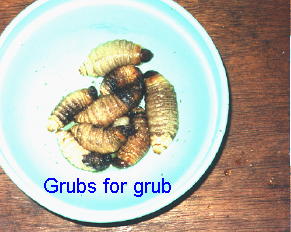 Food was always an adventure. These Tsuri grubs are found in Palm trees and stumps. They are filled with fat and, when cooked with jungle cilantro and garlic, are absolutely delicious. Raw, they squirted and squirmed too much for pleasant eating. They also bite back if you aren't careful! These became Karen's favorites! Food was always an adventure. These Tsuri grubs are found in Palm trees and stumps. They are filled with fat and, when cooked with jungle cilantro and garlic, are absolutely delicious. Raw, they squirted and squirmed too much for pleasant eating. They also bite back if you aren't careful! These became Karen's favorites!
|
|
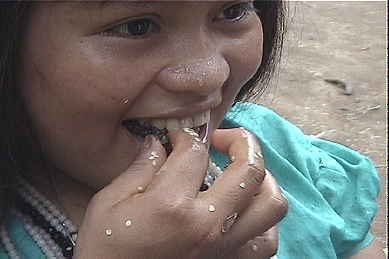 The Indians also like to munch ants right from the earth. This girl is chowing down on a 1 inch long ant. The taste of ants is quite good but you've got to be certain to bite the head... The Indians also like to munch ants right from the earth. This girl is chowing down on a 1 inch long ant. The taste of ants is quite good but you've got to be certain to bite the head...
|
|
Blades and tricks!
|
|
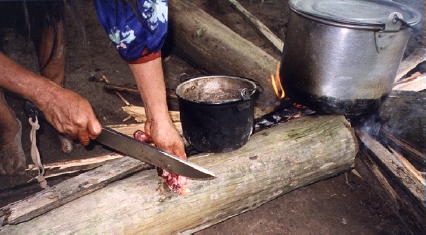 The villagers were enthralled with my Big Bowie The villagers were enthralled with my Big Bowie
Even more exciting was the new "Anaconda" by TOPS and the smaller Simonich "Kanji" blades.
I wish that I'd had my Fehrman Blade along as well
|
|
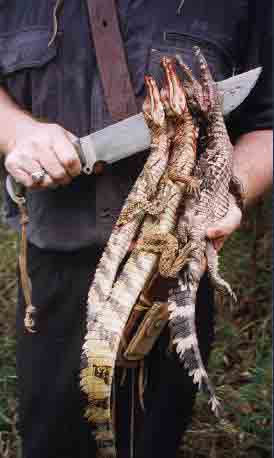
I caught these little Caiman with a snare pole. The little boogers are tough to kill, but a blade in the brain seemed to do the job. We stayed away from the bigger ones since they are much more than we could eat in a day. Even these little guys had enough jaw power in their needle-like teeth to scrape the ceramic coating from one of my knives!
|
|
Toss another Toucan on the fire, Mate!
|
|
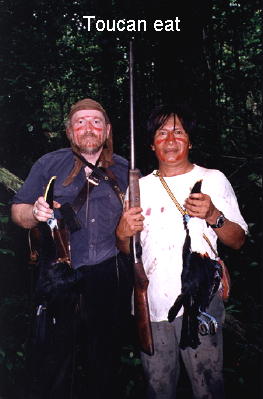 I went hunting with Apu Basha, seen here with his new "T" shirt. He insisted we wear the traditional face paint made with the juice of a seed pod. He bagged these two Toucans with his ancient single-shot 16 Ga. shotgun. Normally I wouldn't shoot these beautiful birds, but the Shapra rely on them for meat and for decorations for their head dresses. If you are wondering, Toucan meat is tough and rubbery. I prefer the grubs. I went hunting with Apu Basha, seen here with his new "T" shirt. He insisted we wear the traditional face paint made with the juice of a seed pod. He bagged these two Toucans with his ancient single-shot 16 Ga. shotgun. Normally I wouldn't shoot these beautiful birds, but the Shapra rely on them for meat and for decorations for their head dresses. If you are wondering, Toucan meat is tough and rubbery. I prefer the grubs.
When you see him hunting, you'll know why these people are masters of jungle living!
|
|
Hard stuff
|
|
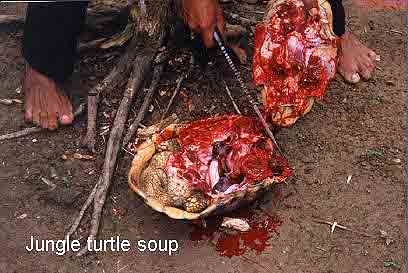 The jungle land turtle is plentiful and an excellent food. They aren't difficult to locate and don't run fast, but they can bite your finger off! This one became a nice stew. Cook them well because they carry intestinal parasites that can ruin your week. The jungle land turtle is plentiful and an excellent food. They aren't difficult to locate and don't run fast, but they can bite your finger off! This one became a nice stew. Cook them well because they carry intestinal parasites that can ruin your week.
You'll see the entire preparation process from start to finish!
|
|
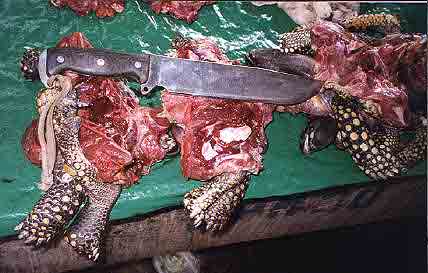 After cleaning the turtle there isn't a lot left to eat. A 7 kilo turtle gives up about the same amount of meat as a 1 kilo chicken. Naturally, there are twice as many legs on the turtle, but somehow they weren't quite as appetizing as a nice barbecued chicken leg. After cleaning the turtle there isn't a lot left to eat. A 7 kilo turtle gives up about the same amount of meat as a 1 kilo chicken. Naturally, there are twice as many legs on the turtle, but somehow they weren't quite as appetizing as a nice barbecued chicken leg.
|
|
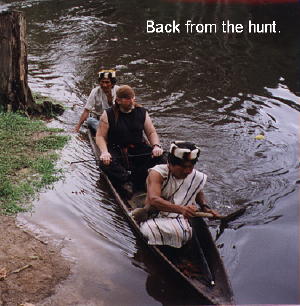 We used dugout canoes to get from location to location. Here, Basha and his brother paddle back to camp with a handsome passenger. Dugouts feel very tippy, but are remarkably stable. I'm holding my fancy Teflon coated blowgun in this photo. It turned out to be an excellent hunting weapon, when used with the native poison tipped darts. We used dugout canoes to get from location to location. Here, Basha and his brother paddle back to camp with a handsome passenger. Dugouts feel very tippy, but are remarkably stable. I'm holding my fancy Teflon coated blowgun in this photo. It turned out to be an excellent hunting weapon, when used with the native poison tipped darts.
|
There is over an hour and thirty five minutes of information in this amazing and informative video...
We think you'll enjoy every moment of it.
This video is available now from HOODS WOODS for only $19.95 per DVD
Order online and save!
Order Here or call
Orders only: Toll Free (888) 257-BUGS (2847) 24 hours
Information: (208) 665-5537 9 AM to 6 PM Pacific time
Idle thoughts
I'm still processing what I saw and learned. Much dream time goes into these experiences. I can tell you that after the trip, while I sat in my hotel room in Lima I was scratching idly at a lump on my foot. It looked a bit like a zit I thought. I squeezed it and a tiny maggot about 1 cm long popped out and wriggled across the bed. "Interesting," I thought, "I wish I'd filmed that."
Another vision clouds that memory. I was in the Shapra village watching a woman cook Tsuri (Grubs) and fooling with my video camera. A naked child ran by outside of the shelter and stopped. I zoomed in on him and started recording because it looked like he was about to do something interesting. He did. He squatted and dumped a steaming load onto the muddy ground. I noticed that this grogan had texture but no shape. I zoomed in on the load and discovered that it was a writhing mass of worms... OOOPS! There are some things I don't want to know.
There was much more. I ate the most expensive dinner of my life... 2 toucans, several blue/green parrots and a wonderful bird I'd never seen before. The Indians are hunters/gatherers and they HUNT... I fed almost every insect I could find... "sweet blood" the Indians said. I was one of the least affected by insect swarms. Citrus juices stopped most of the bites.
We ate the usual stuff... rat, gator, piranha, insects whatever the jungle offered. It was mostly very good. We had Giant Escargot cooked in wild garlic, jungle cilantro, and Tsuri fat. We treated festering sores on sick natives, administered medications to a woman who was dying from a jungle "demon". Cured the disease but had to perform a shamanistic ritual to drive the demon away. The next day she was up and about. We also dealt with the two cultural superstitions that bedevil all who venture into the primitive cultures... There was much more. Most of it is on video.
Ron

Copyright ©1998 Hoods Woods. All rights reserved.
|